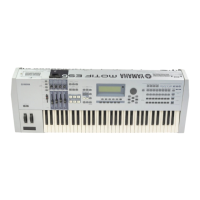
Do you have a question about the Yamaha MOTIF ES series and is the answer not in the manual?
| Polyphony | 128 notes |
|---|---|
| Wave ROM | 175MB |
| Aftertouch | Yes |
| Storage | SmartMedia card slot |
| Sound Engine | AWM2 (Advanced Wave Memory 2) |
| User Voices | 128 x 3 Normal Voices + 32 Drum Kits |
| Sequencer | 16 Tracks, Resolution: 480 ppq, Capacity: Approx. 226, 000 notes |
| Arpeggiator | 1, 787 types |
| Display | 320 x 240 backlit LCD |
| Keyboard | 61 keys |
| Controllers | Pitch bend wheel, modulation wheel |
| Outputs | L/MONO, R, Assignable Outputs, Headphones |
| Inputs | A/D Input L/R |
| MIDI | In/Out/Thru |
| Sampling | Optional via expansion board |
| Connectivity | USB |
| Effects | Reverb, Chorus, Variation, Insertion (5 per voice), Master Effect, EQ |
Master setups organize and memorize Motif ES Programs, Songs, or Patterns into one bank.
Master setups integrate external MIDI gear using Zone Switch for Bank/Program changes.
Master mode recalls Voice, Performance, Song, or Pattern, organizing favorite setups.
Assemble on-board Motif ES setups (Programs) in one bank, recall Performances, Voices, Patterns, or Songs.
Control internal and external sounds, integrating configurations via 4 Zones.
A Voice is the fundamental playable entity, made of up to four multi-sampled sounds (Elements).
A Performance combines up to four Voices, occupying one basic MIDI channel.
128 MASTER Control setups can be created, recalling Voice, Performance, Song, or Pattern MEMORY location.
Motif ES sounds are recalled via standard MIDI messages for Bank Select and Program Change.
Associate MASTER with Performance mode and send MSB/LSB/PC to recall desired Performance.
Zones address internal TG and/or external MIDI sounds, allowing complex setups.
Configure Keyboard Transmit Channel and Basic Receive Channel in UTILITY for Master Mode.
Link a MASTER setup to a specific Voice, Performance, Song, or Pattern memory location.
Demonstrates setting up internal and external sound zones for a combined performance.
Discusses overriding initial sounds, naming masters, and switching limitations.
Utilize Split, 4-Zone, or Layer templates for setting up zone configurations from MASTER mode.
Configure Knob/Slider functions (PAN, TONE, ASSIGN, EQ, EFFECTS, ARP FX, ZONE) per Zone or globally.
Combine internal/external sounds, use MIDI IN, and recall different sounds via Master Zone setups.
MASTER setups are saved in 'ALL' data files and act as pointers to the actual data.
